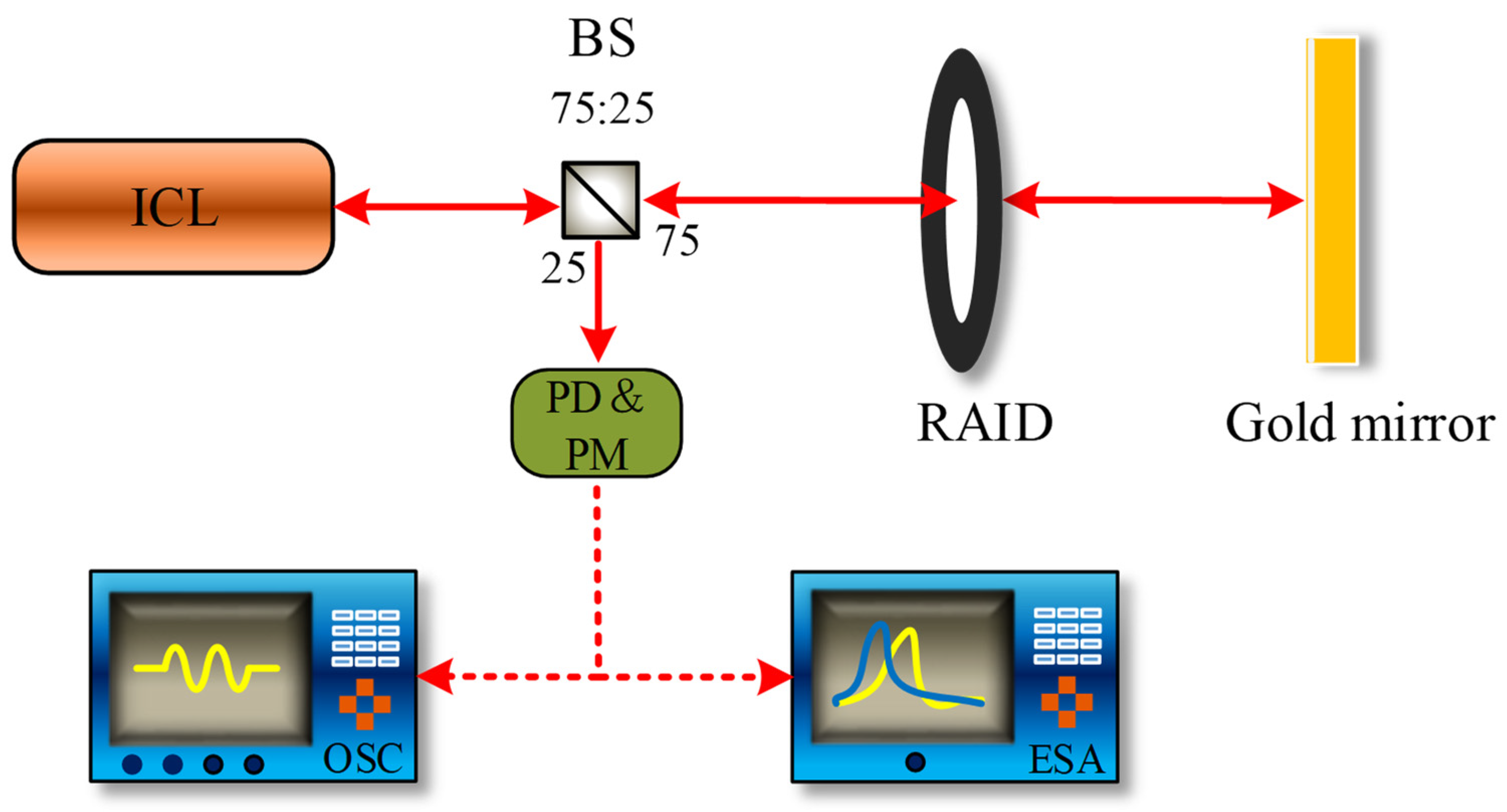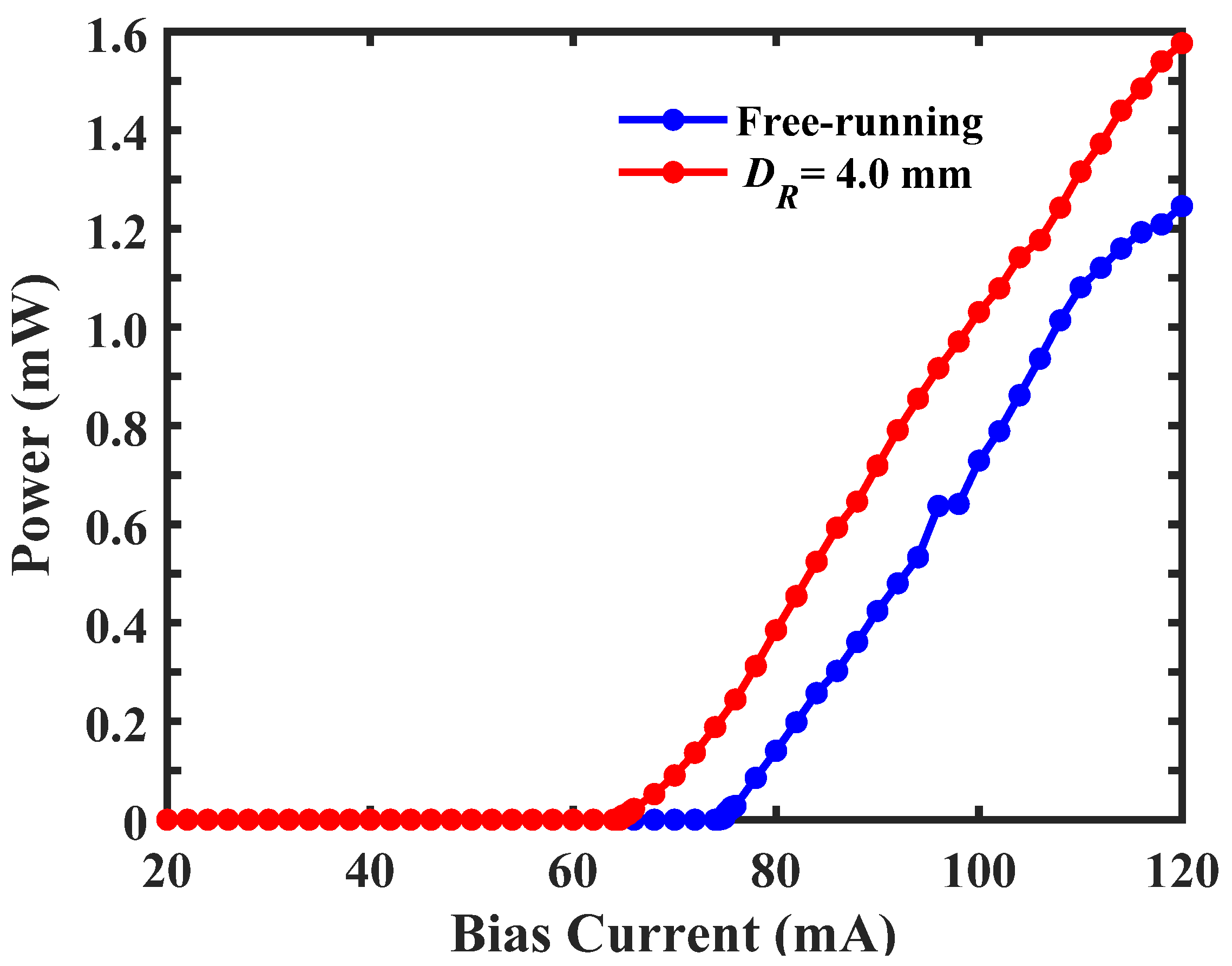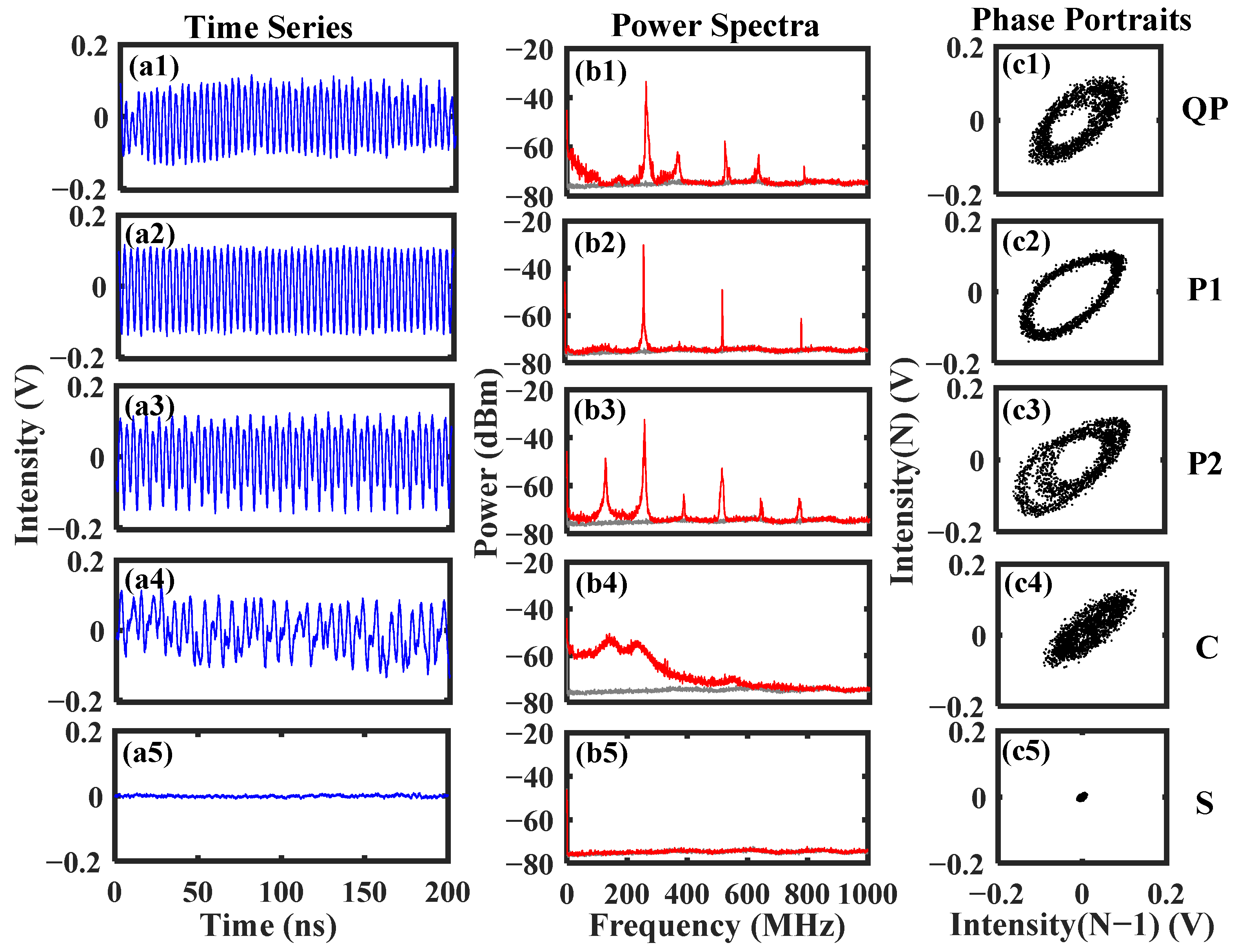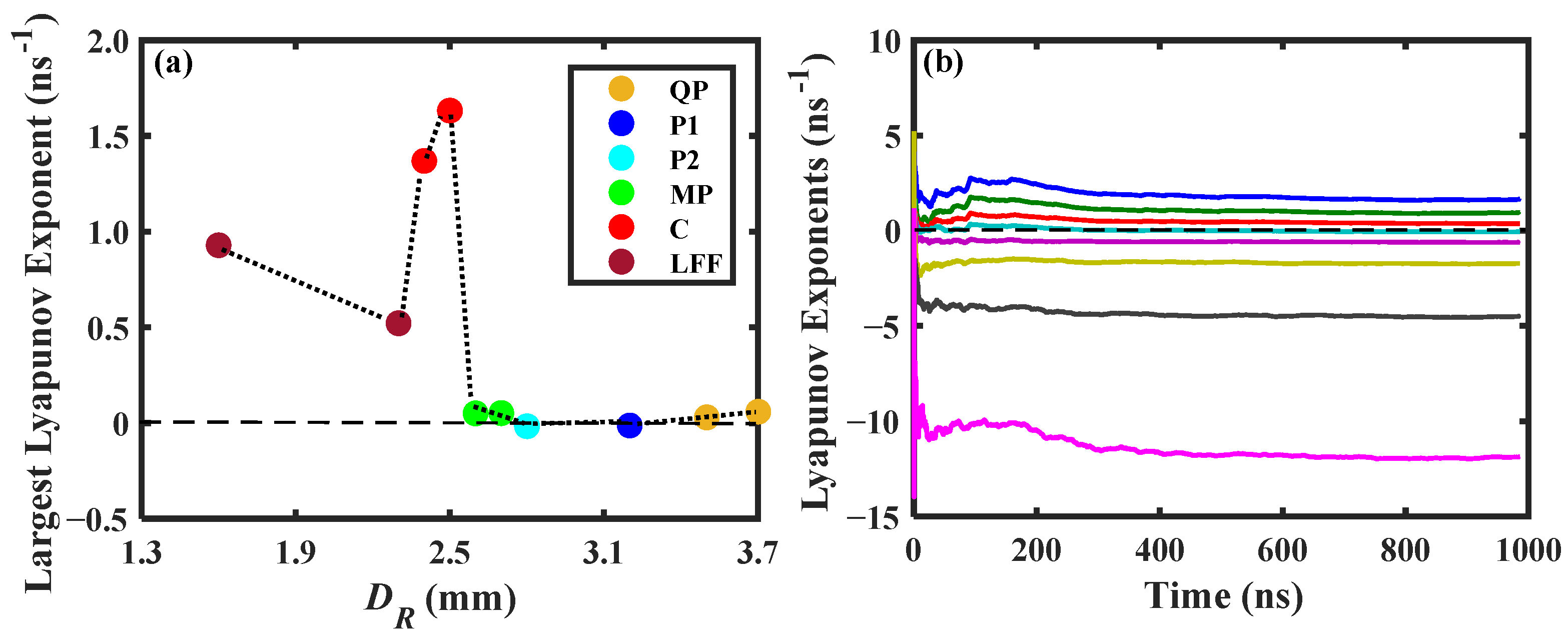Nonlinear Dynamics of Mid-Infrared Interband Cascade Lasers Subject to Variable-Aperture Optical Feedback
Abstract
:1. Introduction
2. Experimental Setup
3. Results
4. Discussion
5. Conclusions
Author Contributions
Funding
Data Availability Statement
Conflicts of Interest
References
- Meyer, J.; Bewley, W.; Canedy, C.; Kim, C.; Kim, M.; Merritt, C.; Vurgaftman, I. The interband cascade lasers. Photonics 2020, 7, 75. [Google Scholar] [CrossRef]
- Ning, C.; Yu, T.; Liu, S.M.; Zhang, J.C.; Wang, L.J.; Liu, J.Q.; Zhuo, N.; Zhai, S.Q.; Li, Y.; Liu, F.Q. Interband cascade lasers with short electron injector. Chin. Opt. Lett. 2022, 20, 022501. [Google Scholar] [CrossRef]
- Vurgaftman, I.; Bewley, W.W.; Canedy, C.L.; Kim, C.S.; Kim, M.; Merritt, C.D.; Abell, J.; Meyer, J.R. Interband cascade lasers with low threshold powers and high output powers. IEEE J. Sel. Top. Quantum Electron. 2013, 19, 1200210. [Google Scholar] [CrossRef]
- Didier, P.; Spitz, O.; Cerutti, L.; Diaz-Thomas, D.A.; Baranov, A.N.; Carras, M.; Grillot, F. Relative intensity noise and intrinsic properties of RF mounted interband cascade laser. Appl. Phys. Lett. 2021, 119, 171107. [Google Scholar] [CrossRef]
- Vurgaftman, I.; Bewley, W.W.; Canedy, C.L.; Kim, C.S.; Kim, M.; Merritt, C.D.; Abell, J.; Lindle, J.R.; Meyer, J.R. Rebalancing of internally generated carriers for mid-infrared interband cascade lasers with very low power consumption. Nat. Commun. 2011, 2, 585. [Google Scholar] [CrossRef] [PubMed] [Green Version]
- Bradshaw, J.L.; Yang, R.Q.; Bruno, J.D.; Pham, J.T.; Wortman, D.E. High-efficiency interband cascade lasers with peak power exceeding 4 W/facet. Appl. Phys. Lett. 1999, 75, 2362–2364. [Google Scholar] [CrossRef]
- Tian, Z.; Li, L.; Ye, H.; Yang, R.Q.; Mishima, T.D.; Santos, M.B.; Johnson, M.B. InAs-based interband cascade lasers with emission wavelength at 10.4 μm. Electron. Lett. 2012, 48, 113–114. [Google Scholar] [CrossRef]
- Liu, Z.W.; Zheng, C.T.; Chen, C.; Li, Y.F.; Xie, H.T.; Ren, Q.; Wang, Y.D.; Tittel, F.K. ICL-based mid-infrared carbon dioxide sensor system for deep-sea natural gas hydrate exploration. Opt. Express 2019, 27, 5598–5609. [Google Scholar] [CrossRef]
- Dong, L.; Li, C.G.; Sanchez, N.P.; Gluszek, A.K.; Griffin, R.J.; Tittel, F.K. Compact CH4 sensor system based on a continuous-wave, low power consumption, room temperature interband cascade laser. Appl. Phys. Lett. 2016, 108, 011106. [Google Scholar] [CrossRef] [Green Version]
- Soibel, A.; Wright, M.W.; Farr, W.H.; Keo, S.A.; Hill, C.J.; Yang, R.Q.; Liu, H.C. Midinfrared interband cascade laser for free space optical communication. IEEE Photonics Technol. Lett. 2010, 22, 121–123. [Google Scholar] [CrossRef]
- Petermann, K. External optical feedback phenomena in semiconductor-lasers. IEEE J. Sel. Top. Quantum Electron. 1995, 1, 480–489. [Google Scholar] [CrossRef]
- Hwang, S.K.; Liu, J.M. Dynamical characteristics of an optically injected semiconductor laser. Opt. Commun. 2000, 183, 195–205. [Google Scholar] [CrossRef]
- Gatare, I.; Sciamanna, M.; Buesa, J.; Thienpont, H.; Panajotov, K. Nonlinear dynamics accompanying polarization switching in vertical-cavity surface-emitting lasers with orthogonal optical injection. Appl. Phys. Lett. 2006, 88, 101106. [Google Scholar] [CrossRef]
- Hong, Y.H.; Spencer, P.S.; Shore, K.A. Wideband chaos with time-delay concealment in vertical-cavity surface-emitting lasers with optical feedback and injection. IEEE J. Quantum Electron. 2014, 50, 236–242. [Google Scholar] [CrossRef]
- Zhong, Z.Q.; Wu, Z.M.; Xia, G.Q. Experimental investigation on the time-delay signature of chaotic output from a 1550 nm VCSEL subject to FBG feedback. Photon. Res. 2017, 5, 6–10. [Google Scholar] [CrossRef]
- Chen, J.J.; Li, C.X.; Mu, X.L.; Li, L.F.; Duan, Y.N. Time-delay signature suppression of polarization-resolved wideband chaos in VCSELs with dual-path chaotic optical injections. Appl. Opt. 2020, 59, 7217–7224. [Google Scholar] [CrossRef]
- Zhao, A.; Jiang, N.; Zhang, Y.Q.; Peng, J.F.; Liu, S.Q.; Qiu, K.; Deng, M.L.; Zhang, Q.W. Semiconductor laser-based multi-channel wideband chaos generation using optoelectronic hybrid feedback and parallel filtering. J. Lightwave Technol. 2022, 40, 751–761. [Google Scholar] [CrossRef]
- Chan, S.C.; Liu, J.M. Tunable narrow-linewidth photonic microwave generation using semiconductor laser dynamics. IEEE J. Sel. Top. Quantum Electron. 2004, 10, 1025–1032. [Google Scholar] [CrossRef] [Green Version]
- Qi, X.Q.; Liu, J.M. Photonic microwave applications of the dynamics of semiconductor lasers. IEEE J. Sel. Top. Quantum Electron. 2011, 17, 1198–1211. [Google Scholar] [CrossRef]
- Huang, Y.; Zhou, P.; Li, N.Q. Broad tunable photonic microwave generation in an optically pumped spin-VCSEL with optical feedback stabilization. Opt. Lett. 2021, 46, 3147–3150. [Google Scholar] [CrossRef]
- Uchida, A.; Amano, K.; Inoue, M.; Hirano, K.; Naito, S.; Someya, H.; Oowada, I.; Kurashige, T.; Shiki, M.; Yoshimori, S.; et al. Fast physical random bit generation with chaotic semiconductor lasers. Nat. Photonics 2008, 2, 728–732. [Google Scholar] [CrossRef]
- Reidler, I.; Aviad, Y.; Rosenbluh, M.; Kanter, I. Ultrahigh-speed random number generation based on a chaotic semiconductor laser. Phys. Rev. Lett. 2009, 103, 024102. [Google Scholar] [CrossRef] [PubMed]
- Argyris, A.; Syvridis, D.; Larger, L.; Annovazzi-Lodi, V.; Colet, P.; Fischer, I.; Garcia-Ojalvo, J.; Mirasso, C.R.; Pesquera, L.; Shore, K.A. Chaos-based communications at high bit rates using commercial fibre-optic links. Nature 2005, 438, 343–346. [Google Scholar] [CrossRef] [PubMed]
- Wu, J.G.; Wu, Z.M.; Tang, X.; Fan, L.; Deng, W.; Xia, G.Q. Experimental demonstration of LD-based bidirectional fiber-optic chaos communication. IEEE Photonics Technol. Lett. 2013, 25, 587–590. [Google Scholar] [CrossRef]
- Lin, F.Y.; Liu, J.M. Diverse waveform generation using semiconductor lasers for radar and microwave applications. IEEE J. Quantum Electron. 2004, 40, 682–689. [Google Scholar] [CrossRef]
- Lin, F.Y.; Liu, J.M. Chaotic lidar. IEEE J. Sel. Top. Quantum Electron. 2004, 10, 991–997. [Google Scholar] [CrossRef]
- Zhong, D.Z.; Xu, G.L.; Luo, W.; Xiao, Z.Z. Real-time multi-target ranging based on chaotic polarization laser radars in the driveresponse VCSELs. Opt. Express 2017, 25, 21684–21704. [Google Scholar] [CrossRef]
- Chen, Y.P.; Yi, L.L.; Ke, J.X.; Yang, Z.; Yang, Y.P.; Huang, L.Y.; Zhuge, Q.B.; Hu, W.S. Reservoir computing system with double optoelectronic feedback loops. Opt. Express 2019, 27, 27431–27440. [Google Scholar] [CrossRef]
- Zhao, B.B.; Wang, X.G.; Zhang, J.C.; Wang, C. Relative intensity noise of a mid-infrared quantum cascade laser: Insensitivity to optical feedback. Opt. Express 2019, 27, 26639–26647. [Google Scholar] [CrossRef]
- Zhao, B.B.; Wang, X.G.; Wang, C. Strong optical feedback stabilized quantum cascade laser. ACS Photonics 2020, 7, 1255–1261. [Google Scholar] [CrossRef]
- Jumpertz, L.; Schires, K.; Carras, M.; Sciamanna, M.; Grillot, F. Chaotic light at mid-infrared wavelength. Light Sci. Appl. 2016, 5, e16088. [Google Scholar] [CrossRef] [PubMed] [Green Version]
- Spitz, O.; Wu, J.G.; Carras, M.; Wong, C.W.; Grillot, F. Low-frequency fluctuations of a mid-infrared quantum cascade laser operating at cryogenic temperatures. Laser Phys. Lett. 2018, 15, 116201. [Google Scholar] [CrossRef] [Green Version]
- Han, H.; Cheng, X.M.; Jia, Z.W.; Shore, K.A. Nonlinear dynamics of interband cascade laser subjected to optical feedback. Photonics 2021, 8, 366. [Google Scholar] [CrossRef]
- Deng, Y.; Fan, Z.F.; Zhao, B.B.; Wang, X.G.; Zhao, S.Y.; Wu, J.G.; Grillot, F.; Wang, C. Mid-infrared hyperchaos of interband cascade lasers. Light Sci. Appl. 2022, 11, 7. [Google Scholar] [CrossRef]
- Wolf, A. Wolf Lyapunov Exponent Estimation from a Time Series. MATLAB Central File Exchange. Available online: https://www.mathworks.com/matlabcentral/fileexchange/48084-wolf-lyapunov-exponent-estimation-from-a-time-series (accessed on 10 January 2022).
- Wolf, A.; Swift, J.B.; Swinney, H.L.; Vastano, J.A. Determining Lyapunov exponents from a time-series. Phys. D 1985, 16, 285–317. [Google Scholar] [CrossRef] [Green Version]
- Ott, E. Chaos in Dynamical Systems; Cambridge University: Cambridge, UK, 2002. [Google Scholar]
- Sprott, J.C. Chaos and Time-Series Analysis; Oxford University: New York, NY, USA, 2003. [Google Scholar]
- Matsumoto, T.; Chua, L.O.; Kobayashi, K. Hyperchaos: Laboratory experiment and numerical confirmation. IEEE Trans. Circuits Syst. 1986, 33, 1143–1147. [Google Scholar] [CrossRef]
- Ferre, S.; Jumpertz, L.; Carras, M.; Ferreira, R.; Grillot, F. Beam shaping in high-power broad-area quantum cascade lasers using optical feedback. Sci. Rep. 2017, 7, 44284. [Google Scholar] [CrossRef] [Green Version]






Publisher’s Note: MDPI stays neutral with regard to jurisdictional claims in published maps and institutional affiliations. |
© 2022 by the authors. Licensee MDPI, Basel, Switzerland. This article is an open access article distributed under the terms and conditions of the Creative Commons Attribution (CC BY) license (https://creativecommons.org/licenses/by/4.0/).
Share and Cite
Zhao, M.; Xia, G.; Yang, K.; Liu, S.; Liu, J.; Wang, Q.; Liu, J.; Wu, Z. Nonlinear Dynamics of Mid-Infrared Interband Cascade Lasers Subject to Variable-Aperture Optical Feedback. Photonics 2022, 9, 410. https://doi.org/10.3390/photonics9060410
Zhao M, Xia G, Yang K, Liu S, Liu J, Wang Q, Liu J, Wu Z. Nonlinear Dynamics of Mid-Infrared Interband Cascade Lasers Subject to Variable-Aperture Optical Feedback. Photonics. 2022; 9(6):410. https://doi.org/10.3390/photonics9060410
Chicago/Turabian StyleZhao, Maorong, Guangqiong Xia, Ke Yang, Shuman Liu, Junqi Liu, Qiupin Wang, Jianglong Liu, and Zhengmao Wu. 2022. "Nonlinear Dynamics of Mid-Infrared Interband Cascade Lasers Subject to Variable-Aperture Optical Feedback" Photonics 9, no. 6: 410. https://doi.org/10.3390/photonics9060410
APA StyleZhao, M., Xia, G., Yang, K., Liu, S., Liu, J., Wang, Q., Liu, J., & Wu, Z. (2022). Nonlinear Dynamics of Mid-Infrared Interband Cascade Lasers Subject to Variable-Aperture Optical Feedback. Photonics, 9(6), 410. https://doi.org/10.3390/photonics9060410




